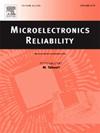模盖形状对焊料热界面材料中空洞形成的影响
IF 1.9
4区 工程技术
Q3 ENGINEERING, ELECTRICAL & ELECTRONIC
引用次数: 0
摘要
热界面材料(TIM)是用来改善表面之间的传热,如模具和盖子。由于其高导热性,Solder-TIM是有盖电子封装的流行选择,可以在操作期间有效地从计算芯片中去除热量。然而,焊料- tim容易在盖子和模具之间形成空洞,从而降低了传热效率。在本研究中,计算流体动力学(CFD)研究了不同模盖形状下焊料- tim空化的机理和行为。仿真结果与实验结果的误差小于1%。结果表明,模具形状是影响焊料空化的关键因素。在相同平面度为60 μm的情况下,凹模在模中心附近产生了30%的空隙,而凸模在模边缘附近产生了3.66%的空隙。对于盖子形状,发现符合模具形状的盖子减少了气隙,并转化为最小的空隙。对于凹盖与相同平面度的凸模相匹配,焊锡- tim空洞率从3.66%显著降低0.55%。该研究表明了模具和盖子形状对了解焊料漏焊行为和减轻漏焊行为的准确方法的重要性。本文章由计算机程序翻译,如有差异,请以英文原文为准。
Influence of die and lid shapes on void formation in solder thermal interface materials
Thermal interface material (TIM) is used to improve heat transfer between surfaces such as die to the lid. Solder-TIM is the popular choice for lidded electronic packages to effectively remove the heat from the compute die during operation due to its high thermal conductivity. However, solder-TIM is susceptible to form voids between the lid and the die which reduces the heat transfer effectiveness. In this study, computational fluid dynamics (CFD) was used to understand the mechanisms and behaviors of solder-TIM voiding for different die and lid shapes. Results from the simulations were validated with error less than 1 % to the experiments. It was found that the die shape is a crucial factor that influences the solder-TIM voiding. At same flatness of 60 μm, concave die resulted more voids at 30 % located near the die centre as compared to 3.66 % voids for convex die located near the die edges. For the lid shapes, it was found that conforming the lid to the die shape reduces the air gaps and which translated to minimum voids. For concave lid matching to convex die of same flatness, significant solder-TIM voids reduction of 0.55 % from 3.66 % was observed. This study signifies the importance of die and lid shapes to understand the solder-TIM voiding behavior and accurate method to mitigate it.
求助全文
通过发布文献求助,成功后即可免费获取论文全文。
去求助
来源期刊

Microelectronics Reliability
工程技术-工程:电子与电气
CiteScore
3.30
自引率
12.50%
发文量
342
审稿时长
68 days
期刊介绍:
Microelectronics Reliability, is dedicated to disseminating the latest research results and related information on the reliability of microelectronic devices, circuits and systems, from materials, process and manufacturing, to design, testing and operation. The coverage of the journal includes the following topics: measurement, understanding and analysis; evaluation and prediction; modelling and simulation; methodologies and mitigation. Papers which combine reliability with other important areas of microelectronics engineering, such as design, fabrication, integration, testing, and field operation will also be welcome, and practical papers reporting case studies in the field and specific application domains are particularly encouraged.
Most accepted papers will be published as Research Papers, describing significant advances and completed work. Papers reviewing important developing topics of general interest may be accepted for publication as Review Papers. Urgent communications of a more preliminary nature and short reports on completed practical work of current interest may be considered for publication as Research Notes. All contributions are subject to peer review by leading experts in the field.
 求助内容:
求助内容: 应助结果提醒方式:
应助结果提醒方式:


